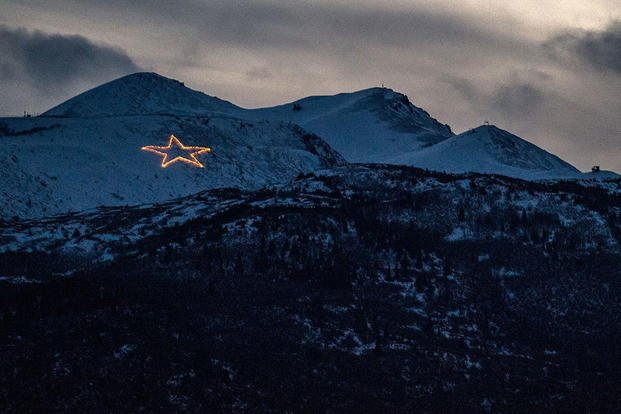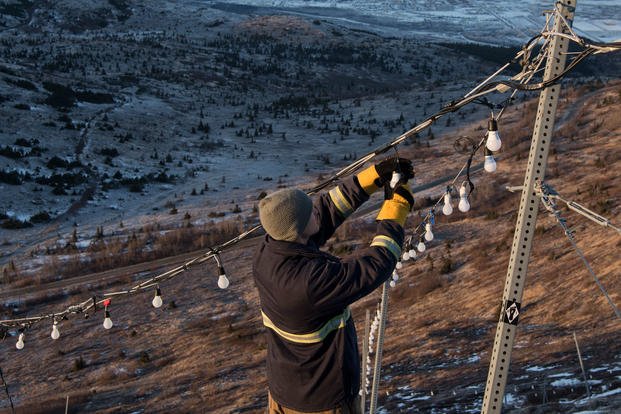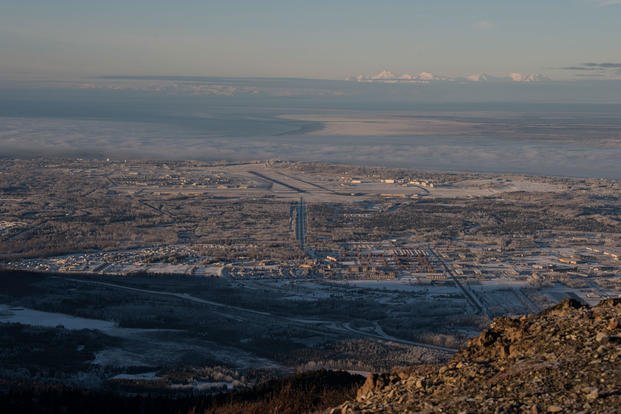JOINT BASE ELMENDORF-RICHARDSON, Alaska — Although the history, location and size of the brightly lit star placed on the side of Mount Gordon Lyon has changed over the last 60 years, the unwavering dedication Airmen and Soldiers have shown to it has not.
The brightly lit star, spanning more than 300 feet, is located in an area just below the old Army Air Defense Command Nike Hercules missile battery - one of three which defended the Anchorage bowl during the Cold War.
Since 2010, Airmen from the 773d Civil Engineer Squadron Electrical shop have assumed caretaking responsibility for it.
"Every year at the beginning of September, we have a team of about 10 Airmen inspect all of the wiring, make repairs, and change out more than 350 light bulbs for the September 11th memorial lighting," said U.S. Air Force Staff Sgt. Steven Andersen, 773d CES Electrical shop exterior electric noncommissioned officer in charge. "Although changing out a light bulb sounds like a very simple job, the terrain and steep angle of the mountain can make it very difficult to navigate. Not only do we have to make sure weather conditions are favorable, we also have to be cleared by range control to be there."
Despite the unforeseeable weather conditions and possible challenges the Airman may face carrying out this Joint Base Elmendorf-Richardson tradition, the lighting during the holiday season always happens on time.
"This year we will be following tradition by trekking up the mountain using four-wheel drive trucks or snow machines to light it the day after Thanksgiving," Andersen said. "It will remain lit until the last musher from the Iditarod crosses the finish line, usually sometime in mid to late March."
Although the star's light comes by using the everyday 60 watt incandescent light bulb, the 773d CES electrical shop has been testing new light-emitting diode (LED) lights that burn brighter and are more energy efficient near the star's tips.
"Each year we are trying out different brands and testing the bulb's ability to withstand the intense weather conditions the star faces throughout the entire season," Andersen said. "Because the star stays lit for more than four months a year we don't want to replace the entire star with LEDs until we know what works the best. The star's symbol has become extremely significant to both the Anchorage community and Joint Base Elmendorf-Richardson over the years. We take a lot of pride in making certain it stays lit for all to see."
At the star's humble beginnings as a 15-foot beacon of light atop the gatehouse of Site Summit, Soldiers from the B Battery, 4th Missile Battalion, 43rd Artillery, were the ones who maintained the lighting during the long wintery nights in those early years.
According to anchorage.net, "The missile site was decommissioned in the late 1970s, but the star has been redesigned, relocated and enlarged through the years. Once just a single point of light in the mountains, the outline of the star near Arctic Valley is now clearly visible from downtown Anchorage, almost 14 miles away."
Another way Airmen from the electrical shop stay prepared for star and other remote location electrical related emergencies is by conducting annual snow machine training during the winter season.
"Even though most of our preparation and repairs for the star happen in September, we train continuously to make sure we are ready to handle any situation no matter what kind of weather we face," Andersen said. "We also go over the history and significance of the star with our Airmen to make sure the legacy continues."
Without the continued efforts and commitment of the 773d CES Airmen, both the history and the light on the mountain would fade out.
















